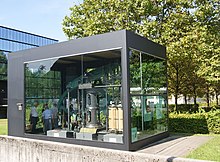Steam engine Kuhn No. 100
The Kuhn No. 100 was built in 1858 by G. Kuhn in Stuttgart for Franz M. Rhomberg. It was the first steam engine from Franz M. Rhomberg and was in operation in this textile company from 1858 to 1921 as a supplement to the water power obtained from the Müllerbach (Dornbirn) (63 years).
The steam engine has been a listed building since 2000. It is the last steam engine of this type in Austria and it has been completely preserved with the centrifugal governor and parallelogram.
Design of the steam engine Kuhn No. 100
The Woolfschen beam engines , such as the steam engine No. Kuhn 100, was a very common and proven steam engine in the 19th century. The Kuhn No. 100 in Dornbirn has the classic cylinders, already arranged in this way by Woolf, side by side and both on one side of the balancer. With this design, both pistons and connecting rods work in unison and in a common network. The balancer is used to transfer the straight piston movement via the push rod and crank to the flywheel ( rotary movement ). The other rods attached to the balancer are used to control the machine (e.g. for the Hick slide for the piston control).
The main disadvantages of this design are:
- the elaborate foundation ,
- the significantly larger space requirement than with later horizontal steam engines or later standing machines with cylinders located above and crankshaft located below,
- the elaborate construction of the balancer and
- the relatively low possible number of revolutions.
Technical data of the Kuhn No. 100
This steam engine is a small version of a fixed, two-cylinder, upright expansion piston steam engine:
- Year of construction: 1858;
- Year of assembly: 1858;
- Location: Schmelzhütterstrasse, Dornbirn
- Function: Power transmission via transmissions in the weaving mill of FM Rhomberg, Dornbirn;
- Power: approx. 12 to 36 hp (9 to 26 kW );
- Vapor pressure: 3.5 to 5.5 atmospheres (4.413 to 6.374 bar );
- Speed approx. 35 / min;
- High pressure cylinder:
- Diameter 255 mm;
- Stroke 677 mm;
- Cylinder capacity 33.21 l;
- Low pressure cylinder:
- Diameter 435 mm;
- Stroke 900 mm;
- Cylinder capacity 133.68 l;
- Ratio of usable volume low-pressure to high-pressure cylinder 1: 4
- Weight of high and low pressure cylinders: 2.5 tons
- Flywheel weight: 3 tons
- Weight balancer: 2.5 tons.
Redevelopment
The Kuhn No. 100 in Dornbirn was professionally restored from 2002 to 2005 by the Vorarlberger Technisches Verein (VTV), “Steam Engine” working group, by Adolf Gstöhl and Walter Bröll, with the accompanying support of the Federal Monuments Office, in around 4,000 working hours.
For demonstration purposes, the steam engine can be switched on by anyone interested using an electric motor.
literature
- Christoph Bernoulli "Bernoulli's Steam Engine Apprenticeship" , Basel 1865.
- Friedrich Freytag, “The stationary steam engines; Bernoulli's Steam Engine Theory ” , Berlin 1911, Springer Verlag.
- Hans Nägele, "" Dornbirner Unternehmer ", Lustenau 1965, p. 42.
Web links
- Steam engine has been restored ( Vorarlberger Nachrichten online from September 17, 2005)
See also
- other preserved steam engines in Dornbirn: Steam engine Rhomberg's factory
Individual evidence
- ↑ Decision of the Federal Monuments Office of November 27, 2000, GZ 13.843 / 3/2000
- ↑ Both cylinders are each at top dead center or vice versa. In the two-cylinder twin steam engines, the pistons are in operation at 90 ° in opposite directions.
- ↑ A balancer was already used by James Watt in his first condensation steam engine to operate water pumps.
Coordinates: 47 ° 24 ′ 32.8 " N , 9 ° 44 ′ 7.3" E


